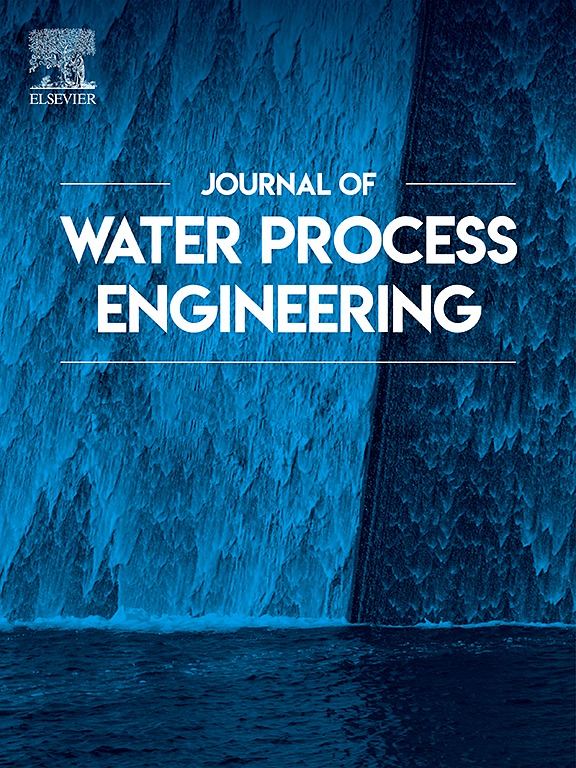Phytotreatment of tofu effluent using water lettuce (Pistia stratiotes) and potential of biogas production from resultant biomass
IF 6.3
2区 工程技术
Q1 ENGINEERING, CHEMICAL
引用次数: 0
Abstract
Tofu effluent contains a high concentration of organic materials, nutrients, suspended solids and is also low in pH. This research was aimed at applying phytotreatment using floating plant species of Pistia stratiotes to polish tofu effluent before final discharge into water bodies while also producing biogas from the resultant biomass after treatment. A range-finding test (RFT) was conducted to determine the initial concentration to be treated and resulted in 10 % tofu effluent. Phytotreatment was conducted for a period of 14 days, focusing on the removal of organic matter and nutrient contents. After 14 days of treatment, P. stratiotes were able to remove total suspended solids (TSS) by 88 %, ammonia by 42.3 %, phosphate by 50 %, chemical oxygen demand (COD) by 84 %, and biological oxygen demand (BOD) by 95 %, significantly higher as compared to control. Phytotreatment was able to stabilize pH to a neutral value, and P. stratiotes were able to transfer oxygen from air to the rhizosphere area. The maximum daily production of biogas using the plant's biomass was higher as compared to the control; however, the overall biogas accumulation was significantly lower during the 45 days of observation. Further biomass pretreatment was suggested before digestion to obtain higher biogas production since the cellulose, hemicellulose, and lignin content inside the plant biomass were subjected to being hardly degraded by the anaerobic microorganisms.
水生菜对豆腐废水的植物处理及由此产生的生物质生产沼气的潜力
豆腐废水中含有高浓度的有机物质、营养物质和悬浮物,ph值也很低。本研究旨在利用浮在海面上的层状豆属植物(Pistia stratiotes)对豆腐废水进行植物处理,在最终排放到水体之前对其进行抛光处理,同时在处理后产生的生物质产生沼气。进行了测距试验(RFT)以确定要处理的初始浓度,结果为10%的豆腐废水。植物处理为期14 d,以去除有机质和养分含量为重点。处理14 d后,层状藻对总悬浮固体(TSS)的去除率为88%,对氨的去除率为42.3%,对磷酸盐的去除率为50%,对化学需氧量(COD)的去除率为84%,对生物需氧量(BOD)的去除率为95%,显著高于对照。植物处理能够将pH稳定在中性值,层状杨能够将空气中的氧气转移到根际区域。与对照相比,利用植物生物量的最大日沼气产量更高;然而,在45天的观察期间,总体沼气积累量显著降低。由于植物生物质中的纤维素、半纤维素和木质素含量很难被厌氧微生物降解,因此建议在消化前进行生物质预处理,以获得更高的沼气产量。
本文章由计算机程序翻译,如有差异,请以英文原文为准。
求助全文
约1分钟内获得全文
求助全文
来源期刊

Journal of water process engineering
Biochemistry, Genetics and Molecular Biology-Biotechnology
CiteScore
10.70
自引率
8.60%
发文量
846
审稿时长
24 days
期刊介绍:
The Journal of Water Process Engineering aims to publish refereed, high-quality research papers with significant novelty and impact in all areas of the engineering of water and wastewater processing . Papers on advanced and novel treatment processes and technologies are particularly welcome. The Journal considers papers in areas such as nanotechnology and biotechnology applications in water, novel oxidation and separation processes, membrane processes (except those for desalination) , catalytic processes for the removal of water contaminants, sustainable processes, water reuse and recycling, water use and wastewater minimization, integrated/hybrid technology, process modeling of water treatment and novel treatment processes. Submissions on the subject of adsorbents, including standard measurements of adsorption kinetics and equilibrium will only be considered if there is a genuine case for novelty and contribution, for example highly novel, sustainable adsorbents and their use: papers on activated carbon-type materials derived from natural matter, or surfactant-modified clays and related minerals, would not fulfil this criterion. The Journal particularly welcomes contributions involving environmentally, economically and socially sustainable technology for water treatment, including those which are energy-efficient, with minimal or no chemical consumption, and capable of water recycling and reuse that minimizes the direct disposal of wastewater to the aquatic environment. Papers that describe novel ideas for solving issues related to water quality and availability are also welcome, as are those that show the transfer of techniques from other disciplines. The Journal will consider papers dealing with processes for various water matrices including drinking water (except desalination), domestic, urban and industrial wastewaters, in addition to their residues. It is expected that the journal will be of particular relevance to chemical and process engineers working in the field. The Journal welcomes Full Text papers, Short Communications, State-of-the-Art Reviews and Letters to Editors and Case Studies
 求助内容:
求助内容: 应助结果提醒方式:
应助结果提醒方式:


